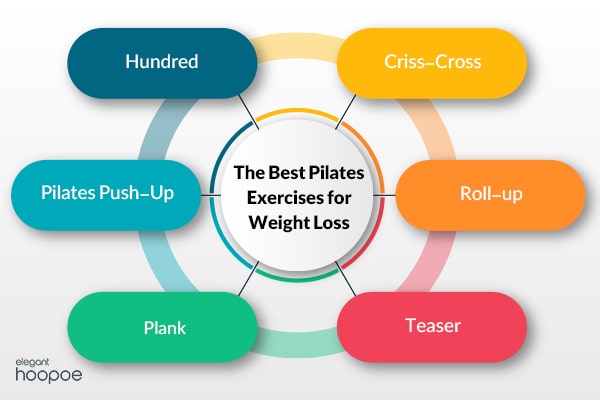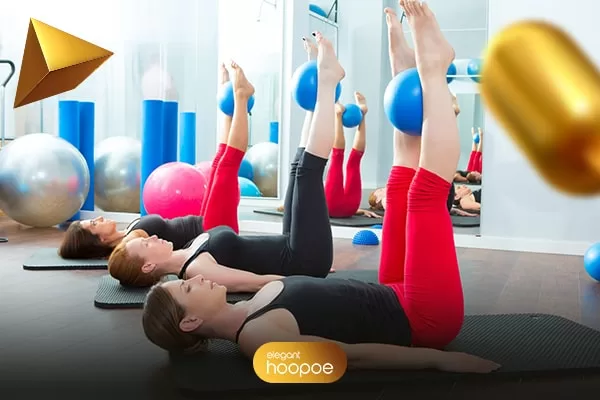If you’ve ever been to a gym, you’ve probably heard of Pilates. How much do you know about this sport and have you ever been trained in Pilates?! These days, Pilates has become one of the most popular sports that many people like to exercise; They like to learn Pilates movements and know their effect on their bodies. The main issue for many people who, in addition to diet, like to use exercise to lose weight; Is whether Pilates is good for weight loss?!
Pilates is a form of low-impact exercise that target building strength, flexibility, and endurance in the body’s core muscles. While Pilates has numerous health benefits, including improved posture and reduced stress, and many people turn to it for these benefits, some also wonder whether this exercise can help with weight loss.
In this article on Elegant Hoopoe, we’ll explore the question that whether Pilates helps lose weight. To answer this question, we must have enough information about Pilates. We also articulate what you need to know if you’re considering Pilates as part of your weight loss strategy.
What is Pilates?
Pilates is a low-impact form of exercise that focuses on developing core strength, flexibility, and balance. It was developed in the early 20th century by German-born Joseph Pilates, who believed that physical and mental health are closely connected.
Pilates exercises for weight loss involve a series of movements and exercises that are designed to improve overall body strength, coordination, and posture. These exercises are typically performed on a mat or with specialized Pilates equipment, such as the reformer, Cadillac, or chair.
Pilates emphasizes mindful movement and controlled breathing, and the exercises are often performed in a slow, deliberate manner. Pilates can be practiced by people of all ages and fitness levels and can be modified to suit individual needs and limitations.
Read more: What are the worst ways to lose weight? Stop these if you are doing them!!

Types of Pilates Exercises
Several types of Pilates have evolved over the years. Each type has its unique approach and emphasis and may use specialized equipment and props. The most common types of Pilates include:
- Classical Pilates or “traditional” Pilates: It adheres closely to the original exercises and philosophy developed by Joseph Pilates and often involves the use of specialized Pilates equipment, such as the reformer, Cadillac, and Wunda Chair.
- Contemporary Pilates: It has evolved to incorporate new exercises and techniques, and may use props such as resistance bands, balls, and foam rollers. This type of exercise often emphasizes functional movement patterns and modifications to suit individual needs and limitations.
- Stott Pilates: It was developed by Moira Stott-Merrithew and emphasizes anatomical principles. It uses a modified form of the original exercises and often uses props and specialized equipment, such as the stability ball and reformer, and may incorporate other forms of exercise, such as cardio and strength training.
- Winsor Pilates: It was developed by Mari Winsor and emphasizes a series of exercises performed on the mat. This type of Pilates often incorporates faster-paced movements and may use modifications to increase intensity.
- Power Pilates: It emphasizes strength and conditioning and incorporates high-intensity exercises and resistance training. It often uses props and specialized equipment, such as the tower and reformer, and is geared toward athletes and those looking for a more challenging workout.
The Benefits of Pilates for Weight Loss
Indeed, Pilates is not typically viewed as a high-intensity exercise like running or weight lifting, but it can still be an effective and useful tool for weight loss when combined with a healthy lifestyle, including a healthy, balanced diet and other forms of exercise such cardio and strength training. This exercise is designed to engage the deep muscles of the core, which can help improve overall body composition and increase muscle tone.
Pilates’ ability to help build lean muscle mass is one of its primary benefits. It involves slow, controlled movements that engage the deep muscles of the core. Muscle tissue burns more calories than fat tissue, even at rest. Thus, increasing muscle mass through Pilates can help increase your resting metabolic rate, and this can lead to more efficient calorie burning and ultimately, weight loss.
In addition to its muscle-building benefits, Pilates can also help improve overall cardiovascular health and increase flexibility, which can make it easier to engage in other forms of exercise and maintain an active lifestyle. Moreover, Pilates can help reduce stress, which can be a key factor in weight gain and difficulty losing weight. Pilates can help reduce stress and promote relaxation through mindful breathing and movement, which can help regulate cortisol levels and reduce the body’s stress response.
Relate article: pear shaped body
What Does the research says?
Pilates can help improve overall body composition by targeting specific muscle groups and improving posture. This can lead to a more toned, streamlined appearance and improve overall body confidence. Finally, it is a form of exercise that is accessible to people of all ages and fitness levels. It can be modified to suit individual needs and limitations, making it a great option for anyone looking to start or continue their weight loss journey.
Multiple studies have been conducted on Pilates to see if this unique system of working out is effective for losing weight or not and all of them proved that it can be a great option for obese and overweight people who would like to shed some pounds. For instance a 2021 study found that Pilates is effective for reducing body weight and body fat percentage in those with obesity. Also this study reported that the longer an individual performs Pilates the more significant the result will be. Another benefit of this type of exercising is that it does not put much pressure on the joints compared to other form of working out such as running which could be a great deal for obese people and those with BMI higher than 30.
Suggested content: What are the Best Cardio workouts?
How Often Should You Do Pilates to Lose Weight?
The Journal of Bodywork and Movement Therapies published an older review of studies on the effects if Pilates in body composition which reported that doing at least sixty minutes of Pilates and for five times a week for one month is best to encourage significant changes in body. That being said doing moderate to intense exercises is much more effective that Pilates and each individual should perform at least 150 minutes of working out in a single week.
Related article: How to Get a Six Pack: Helping Clients with Their Core

The Best Pilates Exercises for Weight Loss
While Pilates is not typically thought of as a best weight loss exercises, and may not be the most effective form of exercise for weight loss compared to high-intensity cardio workouts, it can be a beneficial component of a weight-loss program. It can be also an effective way to burn calories, build lean muscle mass, and improve overall fitness. Some of the best Pilates exercises that can be particularly effective for weight loss include:
- Hundred
lying on your back with your legs lifted and extended and your arms reaching towards your feet. You then pump your arms up and down while breathing deeply, repeat this movement 100 times. Hundred engages the core muscles increases heart rate, and makes it a great calorie burner.
- Pilates Push-Up
Start in a plank position, lowering your body down to the ground while keeping your elbows close to your sides, and pushing back up to the plank. It can help to strengthen the chest, triceps, and core.
- Plank
It is a classic exercise that targets the core, shoulders, and arms. Start in a push-up position with your arms straight and your body in a straight line. Hold this position for 30 seconds to 1 minute, focusing on keeping your core engaged and your body stable.
Read more: Is losing weight good for back pain? How weight loss can affect back pain?
- Criss-Cross
lying on your back, lifting your legs off the ground, and twisting your upper body to alternate touching your elbow to the opposite knee. It can help to strengthen the obliques and improve core stability.
- Roll-up
lying on your back with your arms reaching overhead and your legs extended. Slowly curl up and reach towards your toes, then roll back down one vertebra at a time. This exercise engages the abdominals and helps to improve flexibility and mobility.
- Teaser
It is an advanced Pilates exercise that involves sitting up with your legs extended and lifted off the ground. You then reach your arms forward and lift your body into a V-shape, balancing on your sit bones. This exercise engages the entire core and requires strength and stability.
Pilates and Cardio: The Benefits of Combining Exercise Modalities for Weight Loss
Combining Pilates and cardio can be an effective way to achieve weight loss goals. Pilates is a low-impact, muscle-strengthening workout that focuses on improving posture, flexibility, and balance. It can help tone muscles and increase core strength, which can support weight loss efforts by improving overall fitness levels and reducing the risk of injury during other workouts.
Cardiovascular exercise, on the other hand, helps burn calories and increase heart health. It involves activities such as running, cycling, or swimming, which get the heart rate up and keep it elevated for a sustained period. Cardiovascular exercise is important for weight loss because it can burn calories both during and after the workout, boosting metabolism and supporting fat loss.
Related content: Most of you are looking for the best workouts to lose belly fats and in this article we have explained how and which exercises might be better for you.
Combining Pilates and cardio can be especially effective for weight loss because it offers a balanced approach that targets both muscle tone and cardiovascular fitness. Pilates can be used as a warm-up or cool-down for cardio workouts, helping to prevent injury and improve flexibility. Additionally, Pilates can be used to target specific muscle groups that are important for cardio exercises, such as the core and glutes, which can improve performance and reduce the risk of injury.
Beginner Pilates Exercises for Overweight or Obese Individuals
Pilates can be a great exercise option for overweight or obese individuals because it is low-impact and can be easily modified to fit different fitness levels. Here are some beginner Pilates exercises that can be beneficial for those starting:
- Pelvic Tilt: Lie on your back with your knees bent and feet flat on the floor. Engage your abdominal muscles and slowly tilt your pelvis up towards your belly button, flattening your lower back against the floor. Release and repeat.
- Leg Circles: Lie on your back with your legs extended up towards the ceiling. Slowly rotate your legs in a circular motion, making small circles with your feet. Repeat in the opposite direction.
- Bridging: Lie on your back with your knees bent and feet flat on the floor. Engage your glutes and lift your hips towards the ceiling, keeping your feet and shoulders grounded. Hold for a few seconds and release.
- Modified Side Plank: Lie on your side with your bottom arm extended out and your knees bent. Lift your hips off the floor, creating a straight line from your head to your knees. Hold for a few seconds and release. Repeat on the other side.
- Modified Push-Ups: Begin in a tabletop position with your hands and knees on the floor. Slowly lower your chest towards the ground, keeping your elbows close to your body. Push back up to the starting position and repeat.
Remember to always listen to your body and modify exercises as needed. As you progress, you can increase the intensity and difficulty of your Pilates workouts. It is also important to consult with a healthcare professional before starting any new exercise program.
Related article: Best Glute Workout for Women
Pilates for Belly Fat: Building Core Strength and Improving Body Composition
Pilates can be a great way to build core strength, which can help reduce belly fat and improve body composition. Here are some ways Pilates can help:
- Targeting the Core: Pilates exercises are designed to target the deep muscles of the core, including the transverse abdominis, which is the muscle that pulls the belly button towards the spine. Strengthening these muscles can help improve posture, reduce back pain, and create a more toned appearance in the abdominal area.
- Full-Body Workouts: Many Pilates exercises engage multiple muscle groups at once, providing a full-body workout that can help burn calories and promote weight loss. Additionally, Pilates can help improve flexibility and mobility, which can make other forms of exercise more effective.
- Mind-Body Connection: Pilates encourages a mind-body connection, which can help individuals become more aware of their body and its movements. This can lead to more mindful eating habits and better overall health choices, which can contribute to weight loss and improved body composition.
Some effective Pilates exercises for targeting belly fat include:
- The Hundred
- Single Leg Stretch
- Criss-Cross
Remember to always listen to your body and modify exercises as needed. It is also important to consult with a healthcare professional before starting any new exercise program.

Pilates for Weight Maintenance: Using Exercise to Prevent Weight Regain
Pilates can be an effective way to maintain weight loss and prevent weight regain, as it provides a full-body workout that can help increase muscle tone, boost metabolism, and improve overall fitness levels. Here are some ways Pilates can help:
- Maintaining Muscle Tone: Pilates exercises are designed to strengthen and tone the muscles, particularly in the core, hips, and legs. By maintaining muscle mass, the body’s metabolic rate remains high, which can help prevent weight regain.
- Improving Flexibility: Pilates can help improve flexibility and mobility, which can make other forms of exercise more effective. By improving the range of motion and reducing muscle stiffness, Pilates can help individuals perform other exercises with better form and intensity, leading to increased calorie burn and improved weight maintenance.
- Mind-Body Connection: Pilates encourages a mind-body connection, which can help individuals become more aware of their body and its movements. This can lead to more effective workouts and better overall health choices, which can contribute to weight maintenance and improved body composition.
Some effective Pilates exercises for weight maintenance include:
- Pilates Push-Up: Begin in a push-up position, with your hands directly under your shoulders and your legs extended out behind you. Lower your body down towards the ground, keeping your elbows close to your body. Push back up and repeat.
- Side Plank: Lie on your side with your forearm on the ground and your legs extended out straight. Lift your hips off the ground, creating a straight line from your head to your feet. Hold for as long as you can and repeat on the other side.
- Leg Pull: Begin in a plank position, with your hands directly under your shoulders and your legs extended out behind you. Lift one leg towards the ceiling, then lower it down toward the ground. Repeat on the other side.
Related article: How Yoga Helps You Lose Weight?
Concluding Remarks
Pilates and weight loss?! This System of exercise can be an effective way to support weight loss and improve body composition. Pilates exercises are designed to strengthen and tone the muscles, particularly in the core, hips, and legs, which can increase muscle mass, boost metabolism, and burn more calories. It can also improve flexibility and mobility, which can make other forms of exercise more effective.
Moreover, Pilates encourages a mind-body connection, which can help individuals become more aware of their bodies and their movements. This can lead to more effective workouts and better overall health choices, which can contribute to weight loss and improved body composition.
However, it’s important to note that weight loss is a complex process that involves a combination of factors, including diet, exercise, and lifestyle habits. Pilates alone may not be enough to achieve significant weight loss, and it’s important to incorporate other forms of exercise and healthy eating habits to achieve optimal results. It’s also important to consult with a healthcare professional before starting any new exercise program, especially if you have any health concerns or limitations.
Elegant Hoopoe, one of the leading health clinics in Jumeirah Dubai, offers advanced technologies, expert team members, and a long history of providing health care services in the Middle East, using unique treatments, slimming, weight loss, and body shaping in Dubai. Furthermore, our clinic offers nutritionists, exercise trainers, dietary psychologists, and support personnel to assist you in your journey.







